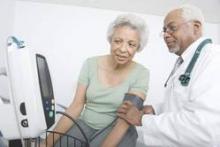Physicians seem to be unwilling to reduce the dose used of antihypertensive and hypoglycemic medications in older patients, even when these treatments reduce blood pressure and hemoglobin A1c to well below recommended levels and can cause clear harm, according to a report published online Oct. 26 in JAMA Internal Medicine.
This indicates that clinicians must adopt a new perspective regarding cardiovascular treatments and “assess the harms of intensive therapy just as they do the benefits,” wrote Dr. Jeremy B. Sussman of the Department of Veterans Affairs Center for Clinical Management Research and the University of Michigan’s Institute of Healthcare Policy and Innovation, both in Ann Arbor.
To examine the frequency of cutting the intensity of treatment among older patients with type 2 diabetes, Dr. Sussman and his colleagues performed a retrospective analysis of a Veterans Affairs database, focusing on all primary care patients aged 70 years and older with type 2 diabetes. They assessed pharmacy records from a 1-year period to identify deintensification among 211,667 patients who were receiving antihypertensive medications and 179,991 who were receiving medications to reduce HbA1c. Many had multiple comorbidities, and many were nearing the end of their lives.
A total of 51% of the BP cohort and 20% of the HbA1c cohort achieved blood pressure readings or HbA1c levels either lower or much lower than recommended target levels, yet physicians did not reduce or change their medications. Just as worrisome, patients with very low BP or very low HbA1c were no more likely than were those with normal levels to undergo medication adjustments, the investigators said (JAMA Intern Med. 2015 Oct 26. doi: 10.1001/jamainternmed.2015.5110).
In fact, the majority (61.6%) of patients with very low, potentially dangerous blood pressure did not have their blood pressure measured during the ensuing 6 months, and the majority (79.8%) of patients with very low, potentially dangerous HbA1c did not have their HbA1c measured during the ensuing 6 months. This suggests that health care professionals did not recognize very low levels as a problem in need of monitoring, Dr. Sussman and his associates noted.
Most concerning of all, even patients with very low BP and/or very low HbA1c levels who had a short life expectancy were unlikely to have their medication regimen eased up. Such patients are particularly unlikely to benefit from these therapies and are particularly vulnerable to their adverse effects, the researchers said.
One reason for this kind of overtreatment is that its harms usually are not addressed in clinical guidelines, quality-of-care measures, or pay-for-performance programs. “Until guidelines and performance measures specifically call for deintensification for patients who are at risk for being harmed by overtreatment, rates [of deintensification] are likely to remain low,” they added.


